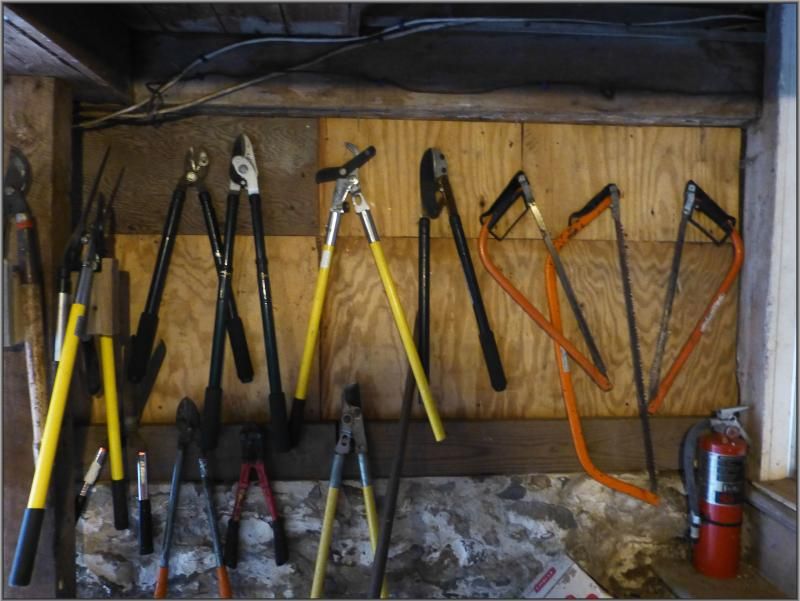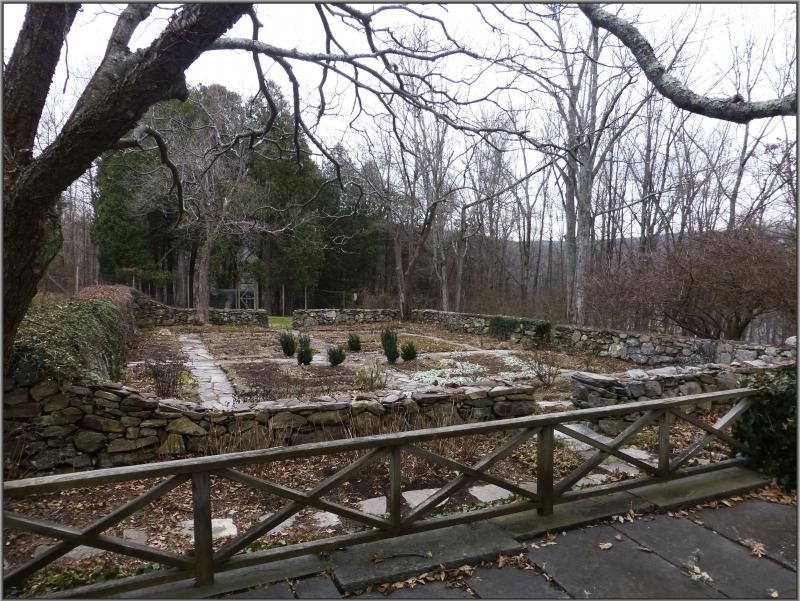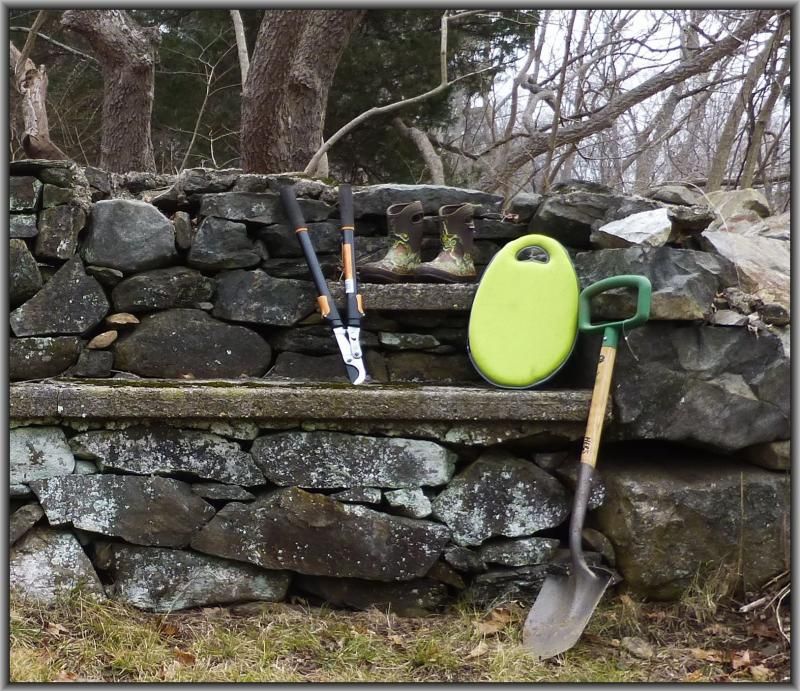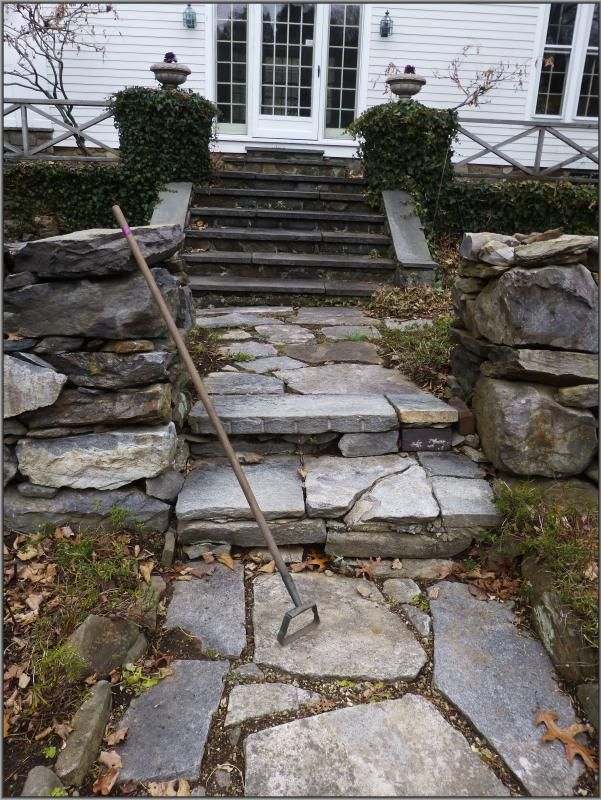CTHG blog entry : Tools of the Trade
Tools of the Trade

The shed area at Three Rivers Farm
Winter is a great time to take a step back and look in the tool shed. Check the dates on soil additives and fertilizers... do you remember buying them? where did they come from? Sometimes I don't even remember! (I try to write the day and year on each bottle/container, I find it helps!) this is the ideal time to set the unused ones aside and discard them if they have not been used in the past year or so. (For information on hazardous waste disposal, check the CT DEP website.)
Every tool shed needs a good sweeping and clearing out, and early winter is a great time to do this.
Set aside any tools that have dirt and need to be sharpened.
Tools should be rinsed off after each use, but sometimes this doesn't always happen. Now is a good time to catch up on this important housekeeping. Make sure the tools are dry before storing them away for the winter. Hang them up on the wall, don't lean them or lay them on the pavement... humidity is not your friend in the tool shed.
Take a look at any shears and loppers, they may have some sap that needs to be removed. Clean this off with a wire brush or stainless steel pot scrubber. Sharpen with a whetstone or any shear sharpening tool. Finally, don't forget to lubricate any pivot point, gears or spring of pruners and shears with WD-40, 3-in-1 Oil or a similar product.
You may want to treat the wooden handles to a 'spa treatment', rubbing them with tung or linseed oil. Dispose of any rags used carefully, these oils are flammable!
Most of all, look around and see if there are any broken tools, plant supports or items that will no longer be necessary in the shed. It's a good time to either fix these things or throw them out.

The garden at rest - hibernating in winter
Hopefully all the hoses have been pulled up and checked for holes/repair. Discard any that look beyond hope, drain and roll up good hoses and put them away in storage. Mulch any plants that will need any winter protection, such as roses. I will wrap the yews in the above photo to protect them from the elements and any deer that may wander into the garden. Taxus baccata is supposed to be deer resistant, but in the northeast in the dead of winter, there is no such thing as deer resistant or deer proof.

What's in a name? Elaphe obsoleta or Elaphe obsoletus or Elaphe alleghaniensis.. Eastern Rat Snake
Do be careful moving items about in the shed... many critters seek shelter from the elements and may decide it's a good place to overwinter. This black rat snake welcomed me one early spring day, but had probably emerged from hibernation after spending it in the den. There are no poisonous black snakes in Connecticut, and these snakes help keep the rat and vole population in check.

Some of my favorite things - what every gardener needs!
Every gardener has those few 'must have' items... and no one 'must have' list is identical! At Three Rivers Farm we have formal garden beds in a sunken stone garden, so a nice padded kneeling pad is a must! I also NEVER leave my house without a GOOD pair of waterproof boots, garden loppers and an ergonomic shovel.

A most helpful tool in the garden - the stirrup hoe
I find myself reaching for the stirrup hoe so often. It's great to cut weeds just below the surface in hard to reach places when you cant just get down and weed certain spots. I first heard of this fast, efficient tool at a lecture by Bob Durgy of the Connecticut Agricultural Experiment Station, Griswold Research Center and now I can't imagine working without it.
For more tips and techniques on tool care please read "Caring for Your Garden Tools", Cornell Cooperative Extension

The shed area at Three Rivers Farm
Winter is a great time to take a step back and look in the tool shed. Check the dates on soil additives and fertilizers... do you remember buying them? where did they come from? Sometimes I don't even remember! (I try to write the day and year on each bottle/container, I find it helps!) this is the ideal time to set the unused ones aside and discard them if they have not been used in the past year or so. (For information on hazardous waste disposal, check the CT DEP website.)
Every tool shed needs a good sweeping and clearing out, and early winter is a great time to do this.
Set aside any tools that have dirt and need to be sharpened.
Tools should be rinsed off after each use, but sometimes this doesn't always happen. Now is a good time to catch up on this important housekeeping. Make sure the tools are dry before storing them away for the winter. Hang them up on the wall, don't lean them or lay them on the pavement... humidity is not your friend in the tool shed.
Take a look at any shears and loppers, they may have some sap that needs to be removed. Clean this off with a wire brush or stainless steel pot scrubber. Sharpen with a whetstone or any shear sharpening tool. Finally, don't forget to lubricate any pivot point, gears or spring of pruners and shears with WD-40, 3-in-1 Oil or a similar product.
You may want to treat the wooden handles to a 'spa treatment', rubbing them with tung or linseed oil. Dispose of any rags used carefully, these oils are flammable!
Most of all, look around and see if there are any broken tools, plant supports or items that will no longer be necessary in the shed. It's a good time to either fix these things or throw them out.

The garden at rest - hibernating in winter
Hopefully all the hoses have been pulled up and checked for holes/repair. Discard any that look beyond hope, drain and roll up good hoses and put them away in storage. Mulch any plants that will need any winter protection, such as roses. I will wrap the yews in the above photo to protect them from the elements and any deer that may wander into the garden. Taxus baccata is supposed to be deer resistant, but in the northeast in the dead of winter, there is no such thing as deer resistant or deer proof.

What's in a name? Elaphe obsoleta or Elaphe obsoletus or Elaphe alleghaniensis.. Eastern Rat Snake
Do be careful moving items about in the shed... many critters seek shelter from the elements and may decide it's a good place to overwinter. This black rat snake welcomed me one early spring day, but had probably emerged from hibernation after spending it in the den. There are no poisonous black snakes in Connecticut, and these snakes help keep the rat and vole population in check.

Some of my favorite things - what every gardener needs!
Every gardener has those few 'must have' items... and no one 'must have' list is identical! At Three Rivers Farm we have formal garden beds in a sunken stone garden, so a nice padded kneeling pad is a must! I also NEVER leave my house without a GOOD pair of waterproof boots, garden loppers and an ergonomic shovel.

A most helpful tool in the garden - the stirrup hoe
I find myself reaching for the stirrup hoe so often. It's great to cut weeds just below the surface in hard to reach places when you cant just get down and weed certain spots. I first heard of this fast, efficient tool at a lecture by Bob Durgy of the Connecticut Agricultural Experiment Station, Griswold Research Center and now I can't imagine working without it.
For more tips and techniques on tool care please read "Caring for Your Garden Tools", Cornell Cooperative Extension